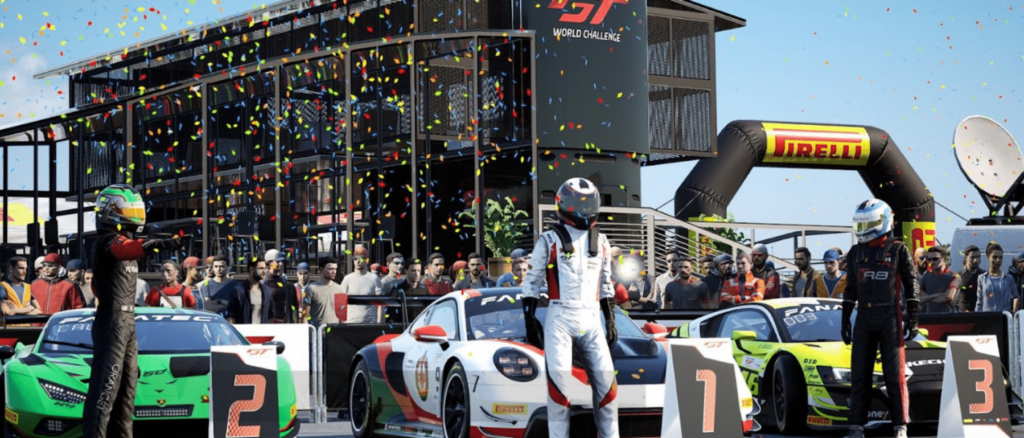
Is the 8Nm of the Fanatec CSL DD / GT DD Pro enough to get the most out of Assetto Corsa Competizione? That’s a question I’ve been asking myself for a long time. And over the months I’ve spent quite a bit of time on the settings of the CSL DD for ACC. So, is my little Fanatec CSL DD up to the task? Let’s find out together..
For my very first article, I wanted above all to share with you my own experience gained from a hundred hours of testing and fine-tuning. At a time when chainstays are becoming more and more powerful, it’s worth asking whether 8Nm is enough. Is my modest direct drive enough to fully enjoy the simulation?
As for Assetto Corsa Competizione (ACC), there’s no need to introduce it any more, as this game has succeeded in satisfying even the most demanding gamers. A benchmark in e-sport and used for the GT World Challenge championship, this game offers a solid foundation for any simracer. But isn’t power everything? Does optimization matter? Let’s get to the bottom of it..
Above all, what follows is above all my own feelings. That of a sim racing enthusiast and the sensations that it can provide behind the virtual wheel. These are my own interpretations that I share with you without wanting to impose any adjustment on you. It’s up to you to see if certain elements can be useful for you or not.
The hardware for this test: Fanatec CSL DD wheel Formula V2.5
If there’s one brand that has revolutionized the direct drive market, it’s Fanatec. The German brand has established itself as the benchmark thanks to its innovations and complete ecosystem. All this with a choice of two ultra-complete software packages.
My first priority was the budget. I had an idea of how much I didn’t want to spend, and the little 8nm CSL DD seemed perfect. But which steering wheel should I choose? As I browsed through the range, one product stood out: Formula V2.5 and its vibrating motors in the grips.
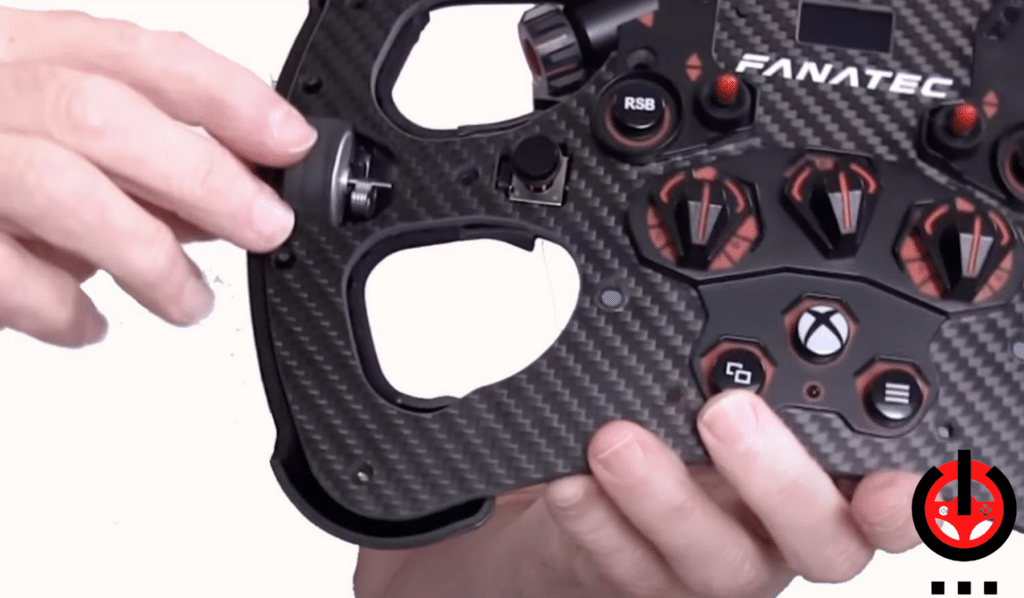
A detail which, to be honest, didn’t catch my eye from the outset. I was more focused on its design and… its price! At four hundred euros, it’s undoubtedly one of the best value-for-money models in this range. And its two little motors housed at the ends of the steering wheel are going to be quite important. But we’ll come back to that a little later in the article.
Discover: Fanatec CSL DD test after 1 year of use
Also: Test of the Fanatec Clubsport Formula V2.5
Setting up your equipment
Before even getting down to setting up the CSL DD and ACC, the first thing I thought about was the driving position in my cockpit. Strange as it may seem, a few millimeters of difference can really have an impact on the transmission of force feedback.
My chassis allows me to adjust the height and depth of the steering wheel very easily. It may seem simplistic at first glance, but a well-transmitted force in the arms is the first stone on the long road to force feedback. In my opinion, it’s even essential for a base with weaker forces. Try it out for yourself, it’s worth spending a few minutes on it.
The right angle of rotation

On the PC, the base and the game communicate perfectly with each other. For a well-mastered steering lock, only 1080 degrees delivers the best performance. According to the manufacturer’s data, in the case of this Fanatec 8nm direct drive. This is an extremely important parameter in the balance of forces. I’m sure I’ll be writing an article about this experience, as there’s so much to discuss on the subject.
On to the Fanalab
This is where things really get tricky. To get the CSL DD set up properly, we have to go through the Fanalab. Between you and me, whether in the game or in the base software, it’s not easy to find your way around. I searched and searched in this veritable gas factory, but I just couldn’t find what I was looking for. If only there were harmony between the game development studios and the direct drive manufacturers. Probably a utopian dream..
To find out more: How to find YOUR ideal FFB in Fanalab
After many trials, I decided to start with a blank sheet of paper and set certain parameters to zero. Keeping the right rotation of two ribs, game and Fanalab, while questioning what was important to keep. I had the feeling that there were conflicts in my settings. Information filtered through, with some rather strange results, to tell the truth.
All reset! [Fanalab Tuning Menu tab]
The main question was: does a direct drive need to have its force feedback signal filtered? It may sound strange, but assuming that the direct drive was capable of taking care of itself seemed to me to be the right decision. I’m sure this comment will cause some debate among you. And yet, we have to admit that it works rather well. The result is balanced, informative and, above all, consistent, whatever the vehicle used.
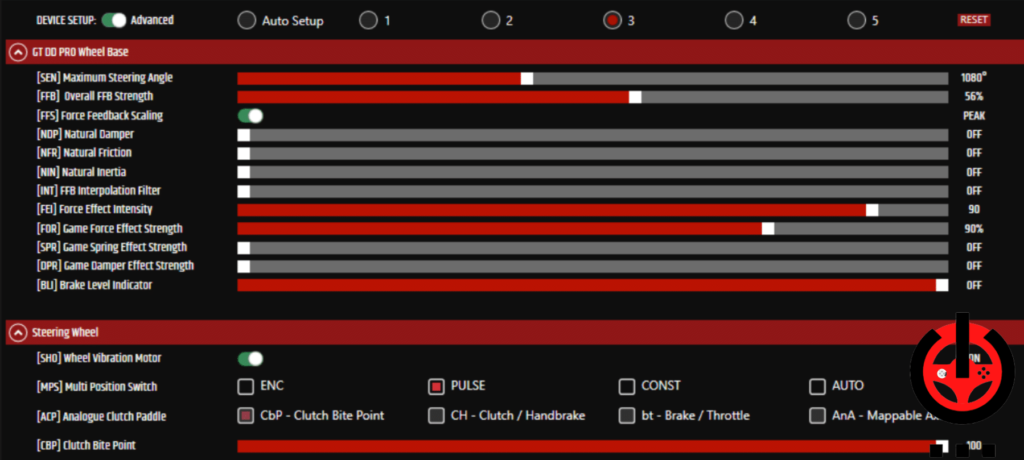
If you’re paying attention, one detail should catch your eye: the balance of power. The power determined in the game, the output, must be the same as the input, the base in my opinion.
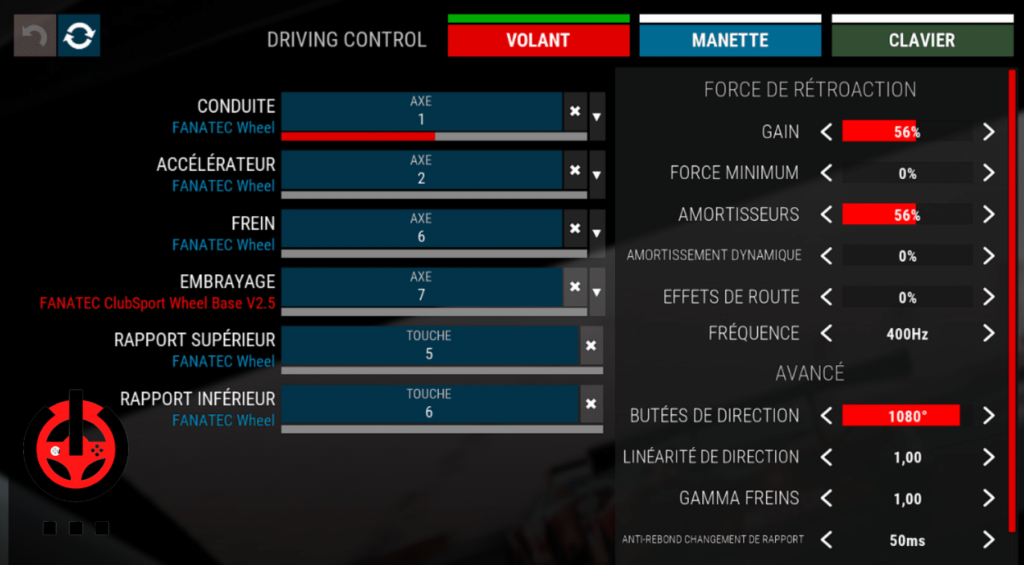
Starting from a low value, 40 for example, and building up to a crescendo seems to me to be the right methodology. After many adjustments, I managed to determine the ideal value, which is 56.
The steering wheel remains smooth, informative and precise. Braking and loss of grip are well felt. Let’s not forget that a GT has power steering.
To sum up, I keep only the parameters that are important to me. Gain and damping on the play side, and FFB, FEI and FOR on the FANATEC side. Given the balanced values, no saturation is to be reported.
Friction [Fanalab Vibrations tab]
If there’s one detail I had trouble determining with my FANATEC base, it’s tire friction when it reaches its cornering limit. The engine vibration parameters in the steering wheel, by default, don’t have much feeling. And yet it’s a gold mine when you take a more serious look at the subject. It’s only the Engine Vibration parameter that still gives me a bit of trouble with its balance. Vibrations seem to be too high on some vehicles, which can be detrimental to the feel.
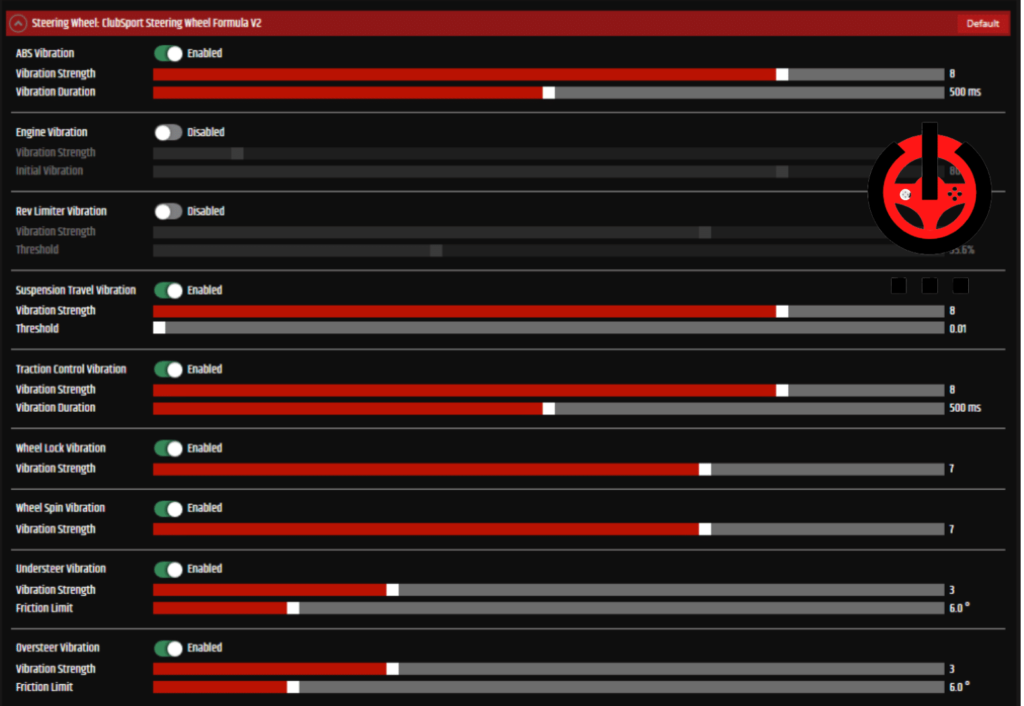
Overall, these settings are impressive, so much so that their shortcomings are felt when they are deactivated. To sum up the VIBRATION tab, it allows you to reinforce the presence of elements already felt in the base force feedback signal.
I even found myself feeling ABS work more precisely. It’s extremely difficult to describe this symbiosis between the base and the vibrating flywheel, but it’s a perfect harmony. A small but important detail: the FANALAB software is the only one capable of handling this. Remember to keep it open during your playing session.
Bounce and rebound
Once I’d found my balance in the previous parameters, there was one detail missing: the suspensions. I felt I was on the right track, but there was something missing. The damping provides that body movement you like to feel in the virtual world.

The value of 56 seems really excellent to me. You’ll notice that the value corresponds to that of the gain. Coincidence? Balance of forces?
FOV modifies FFB on ACC?!!? (so many acronyms!)
Now that we’ve finished tuning Assetto Corsa Competizione’s CSL DD and FFB, we might as well say, ok, we’re good to go, let’s go to the track! Hmm, yes, but no…. There’s one detail that’s often overlooked in ACC, and that’s the driving position in the game. What if I told you that the FOV and the driver’s position have an impact on the FFB? You’ll probably think I’m crazy, but I’m not..
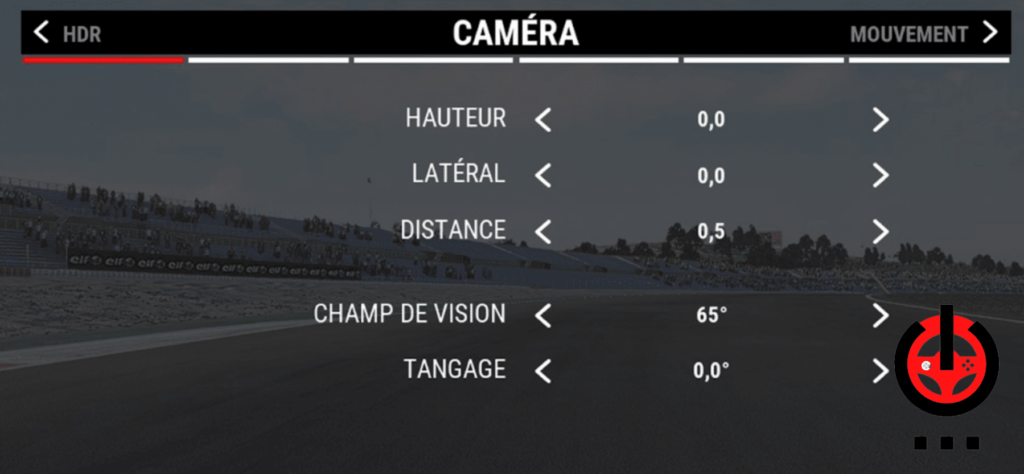
Here’s an example of the latest Porsche GT3. I’ve scoured a lot of forums, but this detail doesn’t really interest anyone, and yet it’s essential. When you’re driving a real vehicle, you like to be well positioned. In ACC, it’s the same thing. The first thing to determine is the FOV. If I may say so, adopt what suits you, not what is said or written elsewhere.
For my part, I really like the value 65, as I retain a good impression of speed while keeping the right proportions on my 32-inch 21:9 screen. Values below 54, by default, give me the impression of a “slowed-down” game. Above 70, it feels like a magnifying glass, with a distorted image.
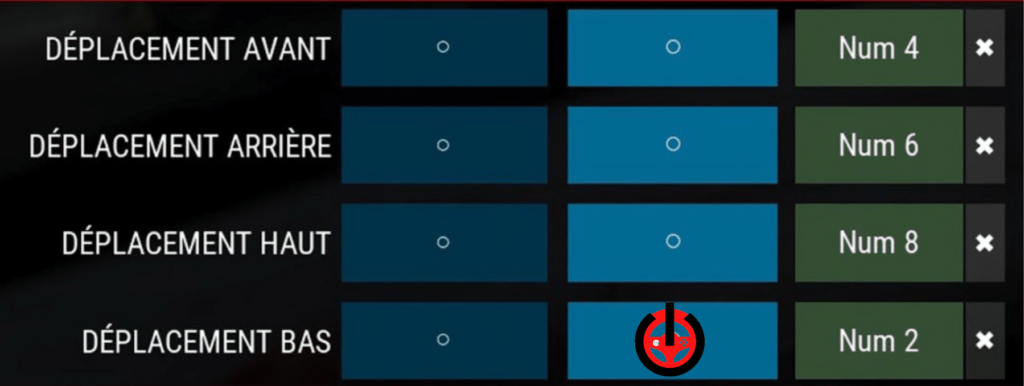
As far as the seat in the vehicle is concerned, the first important point is to determine your keys for adjusting the seat. Don’t hesitate to use the number keys on your keyboard.
Moving the seat a few clicks changes things radically. Moving it up or down also changes the force feedback. Initially, I advise you to limit yourself to adjusting the fore-and-aft movement.
You’ll soon notice that, with the seat moved forward a few clicks, the front end has a greater presence. On the contrary, when you move backwards, you feel the rear end a little more. You soon realize that it’s all a question of balance. With each lap, you change a click and feel more and more confident with the car. It may be a long process, but it’s well worth the effort.
These parameters vary according to your FOV, bearing in mind that each vehicle has its own setting value. Think of these last parameters as a fine-tuning of forces. A balance that will help you feel more confident and progress on the track.
CSL DD tuning is finished, so let’s get on track!
So, did the Fanatec CSL DD set-up on ACC help me get a better grip on the vehicles? The answer is yes! Of course, a more powerful base would undoubtedly provide greater sensations and even more detail. But today, I feel satisfied, because with a controlled budget, I feel I can fully enjoy this simulation. At no time did I doubt the quality of the product and its capabilities.
This Formula 2.5 steering wheel and its vibrations are a real plus, as the sensations are so good with the different settings. It allows you to add elements with finesse, while maintaining a stable signal on the base and without saturation. This little FANATEC is very resourceful, provided you take the time to find the right settings. Mission accomplished, without a doubt. Let’s go for new challenges..
